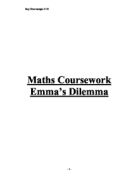Factorial notation is multiplying the total number of letters by the previous consecutive numbers giving the total number of positions and therefore arrangements of the words.
Therefore the formula for total number of combinations for a word with no repeats is C=T! Where C is the total number of combinations and T is the total number of letters factorial. This is my theorem I must now test it.
My formula for a word with no repeats is C=T!
I will now investigate the name PAUL
Using my new formula I can estimate how many arrangements their will be for the name Paul.
Paul= A four letter word.
C=T!
Total number of combinations= 4! (4x3x2x1)
Total number of combinations= 24
I will now investigate the number of combinations for the name Paul and see if my answer is correct.
My answer was correct therefore my formula must work.
Why this formula works
The formula works on the simple principle that once a letter is selected there is one less place for the next letter to go. This carries on down. So by multiplying these numbers together I get the total number of combinations
So the original number of letters is the number of letters factorial.
I am now going try and find how many arrangements a word with repeats has and see how this will evolve my formula.
Emma
The number of letters id the same as the name Paul but the number of arrangements has decreased by half.
We could number the repeated letters but the task was to find different arrangements. Even if we numbered them the arrangements would look the same.
My new formula is C=T!/R!
Total number of combinations= Total number of letters factorial/ By the total number of repeats factorial.
It is divided by the repeats factorial because this shows how many combinations will be made the same because of the repeats dividing by this will remove the repeated arrangements from the total number of combinations.
What happens there are more than one set of repeated letters in the word. For example in the word Mississippi.
The word has 11 letters so:
Total number of arrangements= 11! = 26611200
This is a ridiculous number of combinations to put into a table so I will use my formula to find out how2 many there are including repeats.
Repeats:
Letter I= 4
Letter S= 4
Letter P= 2
The number of repeats should be made factorial and multiplied together to find the total amount I need to divide by to get the number of combinations excluding the ones that are repeats.
So the Brand new formula is C=T!/ A!B!C!
This is where c is the total number of arrangements and T is the total amount of letters factorial. This is the divided by the number of times a letter is repeated factorial multiplied by the other number of times letters are repeated factorial.
So now I have to apply the new formula to the word Mississippi.
C=T!/ I!S!P!
C=11!/ 4!4!2!
C=23100 arrangements with the repeated arrangements removed.
My new formula is correct
Why my formula works
The number of repeats is made factorial because it shows how many combinations will be made the same by the repeats. Dividing by this gets rid of the combinations that are the same because of the repeats.
When you have more that one set of repeats you multiply them together to get the total number of combinations that need to be removed regardless of letter. This is why my formula works.
Conclusion
- To find the total amount of arrangements for a letter with no repeats you use it’s amount of letters and make it factorial.
-
The formula for this is C=T!
- As the number of letters increases so does the amount of arrangements for these letters.
- When there are repeats in the words the number of different combination decreases.
-
A new formula is created to allow for the repeats and by division removes them from the equation. This formula is C=T!/A!B!C!
- The total number of repeated letters are made factorial and multiplied together to give a number that is used in the formula to give the final answer.
- This formula works with all cases regardless of how many letters there are or how many repeats there are this will always work.







